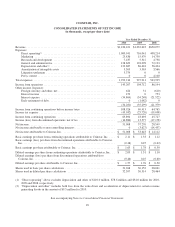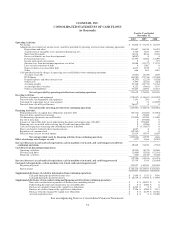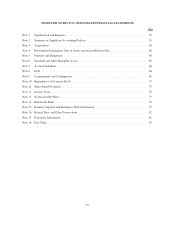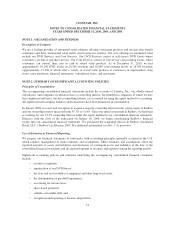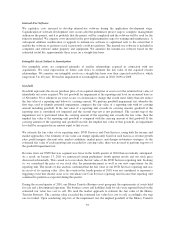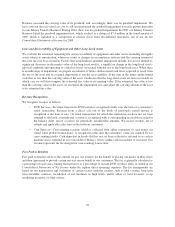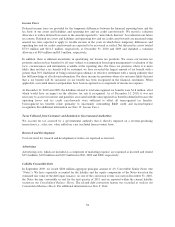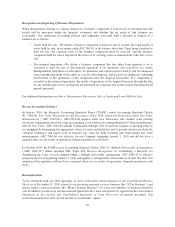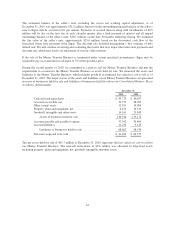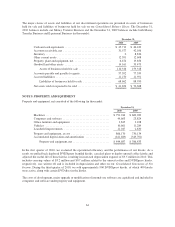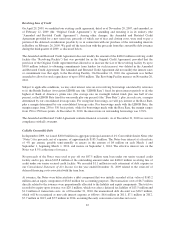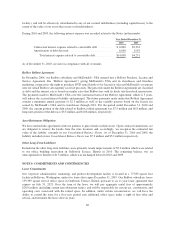Redbox 2010 Annual Report Download - page 67
Download and view the complete annual report
Please find page 67 of the 2010 Redbox annual report below. You can navigate through the pages in the report by either clicking on the pages listed below, or by using the keyword search tool below to find specific information within the annual report.Recognition and Reporting of Business Dispositions
When management commits to a plan to dispose of a business component, it is necessary to determine how the
results will be presented within the financial statements and whether the net assets of that business are
recoverable. Our significant accounting policies and judgments associated with a decision to dispose of a
business are as follows:
• Assets held for sale—We define a business component as held for sale if it meets the requirement of
assets held for sale, in accordance with ASC 360-10, at the balance sheet date. Upon being classified as
held for sale, the carrying value of the business component must be assessed, and the business
component held for sale is reported at the lower of its carrying value or estimated fair value less cost to
sell.
• Discontinued operations—We define a business component that has either been disposed of or is
classified as held for sale as discontinued operations if its operations and cash flows are clearly
distinguishable from the rest of the entity; its operations and cash flows have been or will be eliminated
from ongoing operations of the entity as a result of the disposal; and we have no significant continuing
involvement in the operations of the component after the disposal transaction. If a component is
recorded as discontinued operations, the results of operations of the disposed business through the date
of sale and the gain or loss on disposal are presented on a separate line in the income statement for all
periods presented.
For additional information see Note 4: Discontinued Operations, Sale of Assets and Assets Held for Sale.
Recent Accounting Guidance
In January 2010, the Financial Accounting Standards Board (“FASB”) issued Accounting Standards Update
No. 2010-06, Fair Value Measurements and Disclosures (Topic 820): Improving Disclosures about Fair Value
Measurements (“ASU 2010-06”).ASU-2010-06 requires some new disclosures and clarifies some existing
disclosure requirements about fair value measurement as set forth in Accounting Standards Codification Subtopic
820-10: Fair Value. ASU 2010-06 amends Codification Subtopic 820-10 and now requires a reporting entity to
use judgment in determining the appropriate classes of assets and liabilities and to provide disclosures about the
valuation techniques and inputs used to measure fair value for both recurring and nonrecurring fair value
measurements. ASU 2010-06 was effective for our Company beginning January 1, 2010 and did not have a
material effect on our results of operations, financial position or cash flows.
In October 2009, the FASB issued Accounting Standard Update 2009-13, Multiple-Deliverable Arrangements
(“ASU 2009-13”) which amended ASC Topic 605, Revenue Recognition, by establishing a hierarchy for
determining the value of each element within a multiple deliverable arrangement. ASU 2009-13 is effective
prospectively for us beginning January 1, 2011 and applies to arrangements entered into on or after that date. Our
adoption of this guidance will not have a material effect on our results of operations, financial position or cash
flows.
Reclassifications
To be consistent with our 2010 reporting, we have reclassified certain balances in our Consolidated Balance
Sheets as of December 31, 2009 related to our electronic payment services business (the “E-Pay Business”) and
money transfer services business (the “Money Transfer Business”) to assets and liabilities of businesses held for
sale. In addition, results from our discontinued operations have been retrospectively reported in the Consolidated
Statements of Net Income and Consolidated Statements of Cash Flows for all periods presented. Our
reclassifications had no effect on net income or stockholders’ equity.
59


